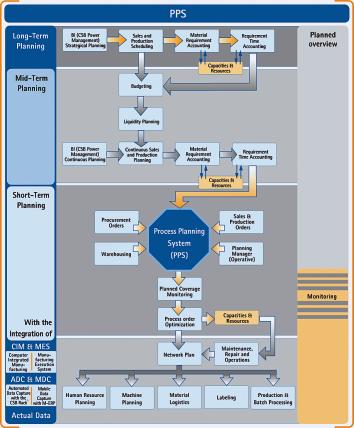A process planning system within a standard ERP solution is faced with the challenge of reconciling the entire spectrum of an industry with the individual requirements of each customer. This problem has been solved with the development of a highly flexible planning tool that fully encompasses the different production processes. Implementation takes place in a freely configurable planning environment that incorporates all essential factors and business cases.
Thomas Lindner, Michael Müller
Day-to-day scheduling of production departments calls for a planning system that also considers machine capacities and material availability in addition to assessing planned independent requirements (PIR). Due to the customer-oriented nature of today’s business relations, which enables orders to be placed up until the early afternoon on the day of loading, both actual sales orders and medium-term sales planning figures have to be taken into account as PIR. Planned independent requirements, i.e. the planned production quantity, are suggested on the basis of the planned warehouse stock, minimum stock level, sales planning quantity and sales order quantity. Multi-level production planning reflects the various manufacturing and setup times (increased response times in production).
In the process planning system, several planning processes can be managed in freely configurable sched-ules. The constructed matrix includes all columns required for calculation and planning development. Data based on user-specified formulae can be prepared in freely definable formula columns. In addition to free data columns, the planning configuration employs sort criteria to organise the view and optimise production sequences (e. g. in order to reduce setup times to a minimum) as well as selection criteria for specifying the planning scope.
The above requirements result in a detailed master data model that accesses BOMs (material usage), PI sheets (machines and production times), working time models (capacities) and setup class models (setup times when an article is changed).
At the start of the planning process, the planning screen consists of four overviews: navigation, planning, totals and requirements. By visualising all information at once, the planner can immediately see the quantities to be produced, the capacities of each department and machine and the availability of the required raw materials. The display is automatically adapted to this selection by navigating on the sort levels.
If the information is sorted according to production dates, cost centres, machines or production articles, in other words, the totals and requirements overviews show the capacities in production time, quantities, etc. separately for each day, department, machine or order. A series of support functions are provided to facilitate fast and convenient planning for larger product assortments. They include conditional batch transfers, default production quantities, lot size adjustments and direct positioning on shortage items.
At the end of the planning process, the planned figures are assigned directly to the selected areas. The areas in question are derived from the necessary operational activities underlying planning. It is consequently possible to generate production orders that include production go-aheads, price marking orders, internal logistics orders and procurement requirements for third-party manufacture or purchased parts.
Dynamic updates in these areas ensure the availability of the results (order quantities, order times, machine occupancies, raw material requirements, staff requirements) throughout the entire material planning system.
Optimisation tool
The system displays information about the consequences of agreed or planned data. If there are problems concerning capacity shortages, adjustments can be made automatically. An optimisation tool with a capacity planning table can be used to suggest a suitable system solution. This application can be opened directly in the rapid planning matrix and the planned order quantities automatically imported. These order quantities are visualised graphically and all alternative manufacturing variants are shown. The planner can then ask the system to generate an optimum suggestion by analysing the manufacturing alternatives and then calculating and displaying the best planning result. This suggestion can subsequently be adjusted manually by the planner if the formulated priorities do not coincide with the actual priorities.
The algorithm works with various optimisation parameters that can be altered in the Settings menu. They include the shortest lead time, earliest start time, optimum setup time, earliest end time, etc., the aim being to reduce the amount of post editing to a minimum. Once the schedule has been completed and the planning levels updated, the results are returned to the planning matrix.
Hall 10.1, Booth F29
cpp 434
More information about PPS
Events
Share:







